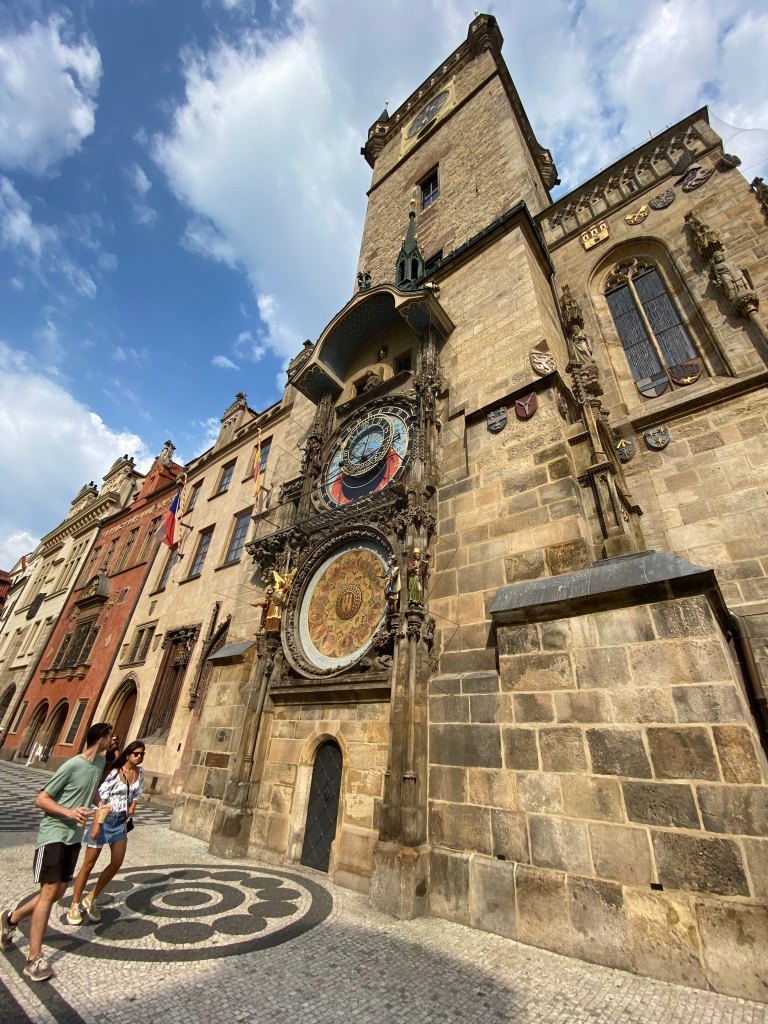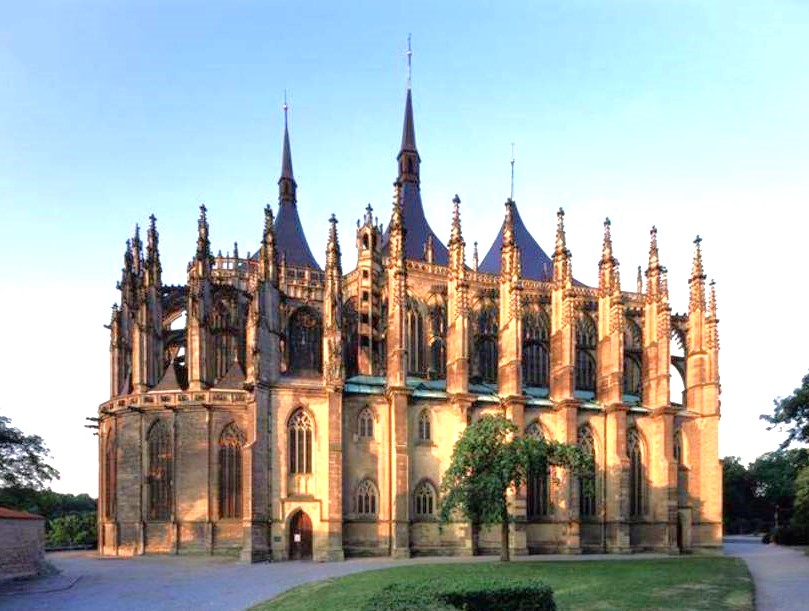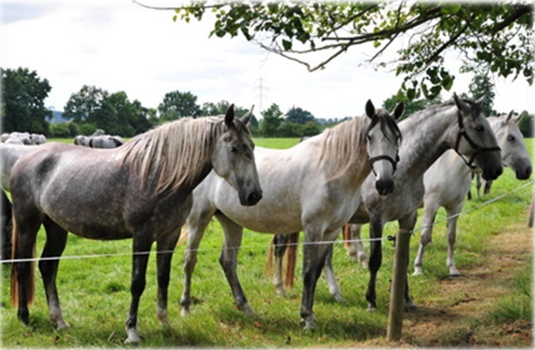Our 9-day, land-based, cycling journey will WOW you when you visit this enchanting destination with our regional guides!
We begin in Prague where our guides and drivers will meet you at your hotel for the van transfer to our first bike ride in nearby Nymburk.

Situated on the banks of the Vltava River, Prague, the Golden City, has been an important European city since the Middle Ages.
Its designation as a UNESCO site is due to several monuments constructed in the Gothic style during the reign of Charles IV, Holy Roman Emperor (1346–1378). Prague Castle, which dominates the skyline of this City of a Hundred Spires, is the largest castle complex in the world. Within its walls lies the magnificent St. Vitus Cathedral, and Golden Lane, a 16th-century street that once housed the royal goldsmiths and now invites curious visitors to shop for local handcrafted wares. Charles Bridge is one of the oldest bridges in Europe that is still in use. The popular pedestrian-only bridge, decorated with thirty statues of saints, has survived floods and the Thirty Years’ War. The city is well served by public transportation making exploration on foot a breeze.
Suggested Reading: Austerlitz, by W.G. Sebald – a novel about a Czechoslovakian child rescued during WWII via the Kindertransport program. Later in life, he searches for the family he left behind.
Suggested Viewing: One Life, directed by James Hawes – a 2023 biographical drama film based on the true story of Sir Nicholas ‘Nicky’ Winton, a young London broker, played by Sir Anthony Hopkins, who, in the months leading up to WWII, rescued over six hundred children from Nazi-occupied Czechoslovakia.
Kutná Hora – silver mining city
In the late 13th century, rich silver deposits were discovered in the area, which led to the development and prosperity of Kutná Hora. In the 14th century, it became a royal city. The historic town center showcases a well-preserved Medieval ground plan. The most noteworthy buildings in the city are the Gothic-style Church of St Barbara, decorated with frescos depicting life in the mining town, and the Cathedral of Our Lady at Sedlec. This former Cistercian monastery church was renovated in the Baroque style in the 18th century. Nearby, one can find the macabre Sedlec Ossuary also known as the Bone Church. The ossuary is estimated to contain over 40,000 skeletons exhumed during the construction of a cathedral around 1400. Many bones have been artistically arranged to form decorations for the chapel.
Suggested Reading: The Black Angel, by John Connolly – a thriller about a young woman who disappears from New York City. Ties of friendship and blood inevitably draw ingenious, tortured detective Charlie Parker into the search for her. Soon he discovers links to a church of bones in Eastern Europe, a 1944 slaughter at a French monastery, and the myth of an object known as the Black Angel – considered priceless by evil men.
Kladruby nad Labem – horse stud farm, breeding ceremonial horses since the 16th century
The stud farm at Kladruby nad Labem was founded in 1579 in a riparian forest on the floodplain of the Labe River. The farm breeds the horses of the Kladruber breed used during the ceremonies at the Habsburg Court. The animal was developed to be a galakarosier – a sturdy carriage horse which pulls imperial coaches at royal celebrations. To this day, these horses perform such duties, most recently for the Royal Courts of Denmark and Sweden. The farm itself is an example of ferme ornée, a specialized decorative farm employing the principles of French and English landscape architecture. In 2019, the farm and surroundings were added to the UNESCO World Heritage List, as an “exceptional example of equestrian cultural development.” Visitors can tour the farm, stables, castle, and lookout tower.

The Litomyšl Castle – a fantastic Renaissance chateau with stunning gardens
Constructed in the Renaissance style as a country residence in the second half of the 16th century, this beauty earned a UNESCO designation in 1999 because it magnificently illustrates the aristocratic residences of central Europe during the Renaissance. Litomyšl Castle is an outstanding and immaculately preserved example of the arcaded castle, a type of building first developed in Italy and modified in the Czech Lands to create an evolved form of special architectural quality. A four-winged, three-story building, its façade features the sgraffito technique, a distinctive method used in painting, pottery, and glass, achieved by applying a layer of plaster to create a preliminary surface, then covering it with subsequent layers of various colors, then scratching the top layer to form a pattern which includes the colors of those underlying layers. The interior of the castle was enhanced in the 18th century with Baroque-style decorations and ceilings. At that time, the family theater was built and remains a source of pride with its well-preserved, original stage machinery and lighting equipment.

Olomouc – Vibrant ancient city you’ve never heard of but will love
This charming city was once the ancient capital of the Moravia Empire. What remains today is a treasure trove of fascinating sculptures, dramatic churches, and a communist-era astronomical clock. UNESCO recognizes the Holy Trinity Column which was erected in the historic center of town in the early 18th century, in the regional style known as Olomouc Baroque. It pays tribute to the victims of a plague that ravaged the city in the 1700s and is the largest of its kind in Europe. There is a small chapel at the base of the column. The column is surrounded by beautiful Gothic, Renaissance, and Baroque buildings. Other sites worthy of your time and admiration include the Archbishop’s Palace, St. Wenceslas’ Cathedral, and the Olomouc Town Hall.
Foraging for Fun Food: Foodies can follow Stephanie as she searches for the local specialty, Olomouc’s own tvarůžky, a Moravian matured (stinky!) cheese made from defatted milk. In 2010, the cheese obtained the status of Protected Geographical Indication within the European Union, protecting it from counterfeiting.
Auschwitz – Birkenau, German Nazi Concentration and Extermination Camp (1940–1945)
Auschwitz was a network of Nazi concentration and extermination camps built and operated by the Third Reich in Polish areas annexed by Nazi Germany during World War II. The World Heritage Site covers Auschwitz I (the base camp), Auschwitz II–Birkenau (the extermination camp), and a mass grave of inmates.
We will pay our respects when we visit the complex which we expect to be an evocative experience for our tour guests. It is the only death camp that UNESCO has designated a World Heritage Site because it represents the “deliberate genocide of the Jews by the German Nazi regime…the deaths of countless others, and bears irrefutable evidence to one of the greatest crimes ever perpetrated against humanity.”
Suggested Reading: A Little Girl in Auschwitz, by Lidia Maksymowicz – No. 1 international bestseller, with a foreword by His Holiness Pope Francis, who made headlines in 2021 when he kissed Lidia’s Auschwitz identification tattoo. This is the unforgettable, moving true story of the little girl who survived Auschwitz’s ‘Angel of Death’, Dr Mengele.

The historic center of Kraków – extend your stay to explore more of Poland’s leading attraction
Chartered in 1257, the UNESCO-designated historic center of this former capital of Poland includes the medieval City of Kraków, and the Wawel Hill complex, the royal residence and cathedral where several kings of Poland are buried. Kraków was a city of arts and crafts, a meeting place of East and West. St Mary’s Church faces Krakow’s marvelous Market Square, which was the largest in Europe when it was built during the Middle Ages. Not to be missed is its gorgeous altarpiece handcrafted from linden, oak, and larch wood between 1477 and 1489. Prepare to be dazzled as you take it all in. Today, in what was once the center of the cloth trade, the Cloth Hall is now home to stalls selling everything from glass ornaments, woodworking, pottery and local amber. Krakow escaped damage during WWII, so its well-preserved architectural history includes styles from the early Romanesque to the Modernist periods.
Suggested Reading: Schindler’s List, by Thomas Keneally – This is the extraordinary story of Oskar Schindler, who risked his life to protect Jews in Nazi-occupied Poland and who was transformed by the war into a man with a mission, a compassionate angel of mercy.
Have we piqued your interest? We would love to welcome you on this tour of discovery into the heart of Europe!
View our full itinerary and pricing here, and contact us today to reserve your space: 2024 Prague to Krakow Bike Tour with Hotel Stays


